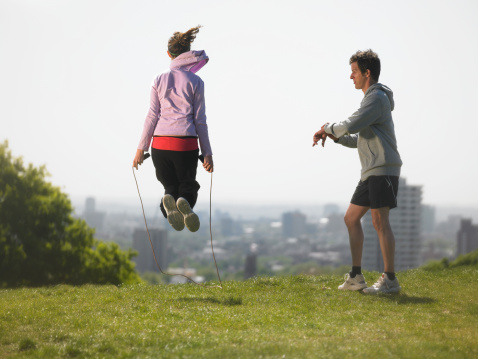Boost workouts with plyometrics

Athletes and even weekend warriors are always looking to improve their strength and performance to give them a competitive edge. Plyometrics (also known as plyos) might just be the key.
Used by track and field athletes in Europe since the 1920s, plyometrics today are incorporated into many sports and fitness workout programs in varying levels of intensity and without the need of any special equipment. Plyometrics are repeated exercises that involve quick stretching and contracting of muscles, such as jumping and rebounding.
Studies published in The Journal of Strength and Conditioning Research have examined the effect on various sports—most recently with 76 youth soccer players.
All players trained twice per week with the test group following a 7-week plyometric program. When comparing results of fitness tests given prior to the study, the test group improved significantly in their countermovement jump height, reactive strength, agility and kicking distance, but no difference in their 20-meter sprint time.
The control group showed no significant improvements. Researchers noted that to improve sprinting performance, athletes should incorporate running exercises in addition to plyometrics.
However, you don’t have to be an athlete with a strong fitness base to add plyometrics to your workout routine. Experts say to begin at your own pace and to remember that plyometrics are not easy. Expect to sweat, feel your muscles burn and you may even notice an increase in your heart rate.
Dr. Steven Chudik, a board-certified sports medicine physician and orthopedic surgeon at Advocate Good Samaritan Hospital in Downers Grove, Ill., says that plyometrics are beneficial and personally has developed several in-season strength and conditioning programs that incorporate plyometrics.
He offers the following tips to those wanting to enhance their own workouts with plyometrics:
- Always warm up for several minutes before beginning any workout. If at any time you feel you are exercising beyond your current fitness abilities, or feel discomfort, discontinue exercise immediately.
- Proper form and technique are important.
- Land softly to absorb the shock. Plyometrics are strenuous impact exercises that may cause injury if done incorrectly. Tendon ruptures around the knee and ankle have occurred in poorly conditioned athletes. Therefore, older athletes also should incorporate flexibility exercises and progress gradually.
- Perform the exercises on cushioned surfaces and wear shoes with plenty of cushioning.
- Allow rest time and recovery between workouts.
- Stop immediately if there is any pain.
Dr. Chudik says to consult with your physician before beginning any type of exercise program.
Related Posts
Comments
One Comment
About the Author
health enews staff is a group of experienced writers from our Advocate Health Care and Aurora Health Care sites, which also includes freelance or intern writers.


















This is definitely a fun way to exercise to keep your cardio going. 🙂